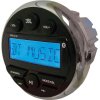You may have noticed in my AutoFair Cruise-in PICs that I put used 60mm high beams. They require a little fabrication.
- I glued the standard SLC fiberglass light cups to the nose.
- I used the springs that came with the 60mm lights, but replaced the screws with long 10-32x2" screws. I then made a mounting plate from thin aluminum sheet with 10-32 rivnuts for the adjustment screws. The thinking is that the thin sheet will flex to allow the angle of the adjustment screws to skew as you aim the lights.
- The SLC light cups were cut to allow the rivnuts and screws to pass thru.
- Lastly, I used 2 rivets near each of the adjustment screws to mount the aluminum mounting plate to the fiberglass light cup.
The result is a solid mount with a good range of adjustability.
Good idea - the plastic adjuster cups tend to pull out and I'm having trouble getting a good headlight adjustment. I'll put together something similar this winter when the car is mostly parked. Thanks for posting up Bill.













